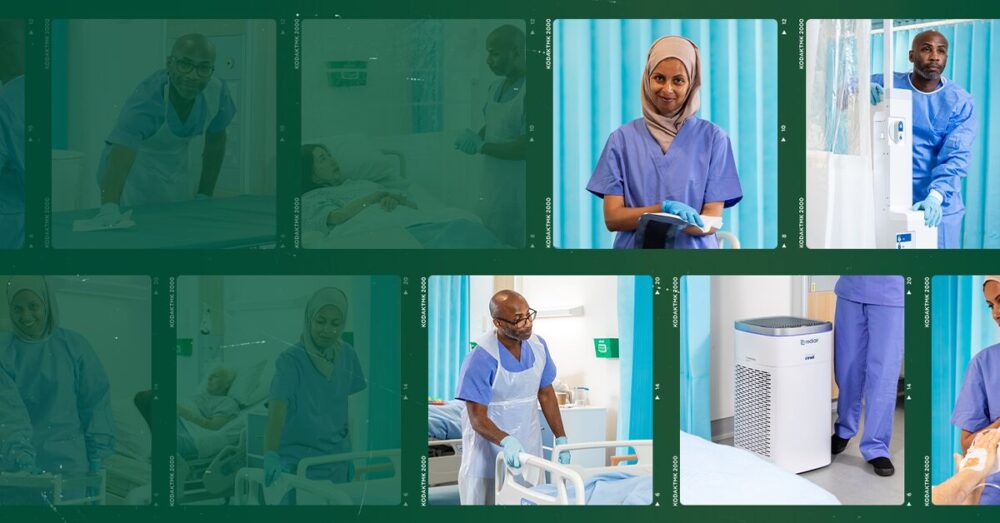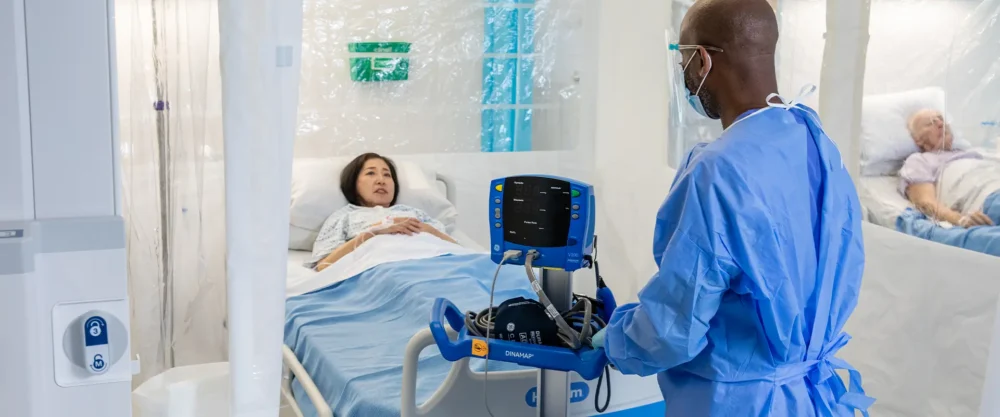Posted
7th May 2021
Research
In our latest article, we discuss how Rediroom increases the options for IPC teams and bed managers through placing patients in the most suitable accommodation, which in turn, reduces the risk of HCAIs and improves patient flow.
The Rediroom has been designed to offer the middle ground between single rooms and multi-occupancy bays – providing many of the benefits of single occupancy rooms (more privacy, less noise, and better containment of pathogens) as well as multi-occupancy bays (patient visibility, and reduced cost in terms of staffing). [1], [2]
Instant mobile patient isolation solution
Single rooms are in short supply in most hospitals in the UK and in hospitals throughout the world. Therefore, an alternative is needed to provide sufficient isolation space to help prevent spread of infection. Rediroom allows you to convert a bed space in a multi-occupancy bay into a single, temporary isolation room in less than five minutes, using a uniquely designed, compact and mobile, unfolding PPE cart.
Rediroom offers flexible patient isolation, allowing hospitals to react quickly when balancing changing clinical and patient priorities. It has been designed to deliver droplet and contact precautions, and frees up existing hard walled permanent isolation rooms for other priority patients.
Most suitable accommodation to reduce the risk of HCAIs and improve patient flow
The Rediroom has been designed for contact and droplet precautions (e.g. MRSA, influenza, SARS-CoV-2, C. difficile), and is not suitable for the containment of pathogens that require airborne isolation (e.g. measles, pulmonary TB). Therefore the Rediroom will not be able to accommodate every patient.
However, it increases the options for IPC teams and bed managers in placing patients in the most suitable accommodation to reduce the risk of HCAIs and improve patient flow.
Application scenarios:
The Rediroom could be applied in the following scenarios to reduce the risk of HCAI and improve patient flow:
- Infectious patients in bays: Single rooms are prioritised for the most infective patients, resulting in other infectious patents being treated in open bays.
- Privacy and dignity:Patients require additional privacy / dignity, but single rooms are occupied by higher priority patients; infective potential often takes priority.
- Forced transfers to other wards:Where single rooms are occupied on speciality wards, patients are transferred to single rooms in alternate wards, where they may not receive the same standard of specialist care.
- Observation and single occupancy: Patients requiring contact isolation and observation present a difficult choice. A single room necessitates one-to-one nursing; providing care in a bay increases the risk of infection.
Rediroom
A mobile cart that expands into a HEPA air-filtered single room with hands-free entry, provides hospitals with greater isolation capacity and flexibility, improving patient flow.
An Australian study:
An Australian study evaluated various functional characteristics of the Rediroom using a mixed methods approach involving video recording, interviews, and objective temperature and humidity measurements, within a crossover intervention study, concluding that the Rediroom had similar functional performance to performing patient care in an open plan area. [1]
In this study, the Rediroom was evaluated in a simulated clinical ward environment. Participants undertook a range of clinical nursing activities in the Rediroom or in a control area, including transferring patients, administration of medications, measurement of observations, performing an aseptic technique, bed bathing a patient, and cardiopulmonary resuscitation. A network analysis of staff movements in the room, and staff feedback via interviews and a questionnaire were used to evaluate the functionality of the Rediroom vs. control area.

Also, temperature and humidity was measured in the Rediroom and control area. The time taken and the number of movements required to complete the clinical nursing activities was broadly similar in the Rediroom and control area. A network analysis of the two activities that involved the most individual movements showed that there was close similarity in the pattern of movements in the Rediroom and control area. Recurring themes from interviews with staff were a sense of restriction, temperature, and management of critically ill patients.
However, it is important to note that the Rediroom was not compared against another single room, but against an open plan area. It is likely that the sense of restriction and temperature themes would be less prominent, if the Rediroom was compared to an isolation room. There was a slight increase in temperature in the Rediroom compared with the control room, of around 0.5oC.
Visit GAMA Healthcare’s Rediroom page.
Further studies:
Another study considered the infection prevention and control characteristics and potential benefits of the Rediroom. [2] The Rediroom was installed in a simulated clinical environment, and its function from an IPC viewpoint was assessed against standards or guidelines, for assembly and dismantling, and for cleanability, as judged by the removal of fluorescent markers were evaluated.

The Rediroom was found to be fully compliant with 17 of 19 relevant guidelines or standards, and partially compliant with the other two. The two guidelines rated as partially compliant, were the storage and use of personal protective equipment, and the provision of additional storage capacity. Another limitation was the lack of a sink for hand hygiene inside the Rediroom, but there is provision for alcohol gel to be situated both inside and outside the Rediroom. The review of assembly and dismantling of the Rediroom identified limited infection control risk.
Installed in less than 5 minutes
Impressively, the Rediroom was installed in less than 5 minutes! Finally, the cleaning assessment found that the UV fluorescent markers were fully removed from 23 (96%) of the 24 surfaces marked, and partially removed from the other surface. Whilst this cleaning assessment was not performed in clinical practice, it demonstrates that the Rediroom does not present a barrier to cleaning in principle.
Request a Rediroom demo.

Summary
Increasing the availability of single rooms for patient isolation helps to prevent the spread of pathogens associated with HCAIs. The Rediroom occupies the middle ground, maximising the benefits of single rooms and multi-occupancy bays. Functional and theoretical evaluation of the Rediroom has demonstrated feasibility for implementation to reduce the risk of HCAIs.
If you’d like to find out more about GAMA’s Rediroom, take a look at our Rediroom page or book a demo by speaking to a member of our Sales team.
[1] Mitchell BG, Williams A, Wong Z. Assessing the functionality of temporary isolation rooms. Am J Infect Control 2017; 45: 1231-7.
[2] Mitchell BG, Williams A, Wong Z, O’Connor J. Assessing a temporary isolation room from an infection control perspective: A discussion paper. Infection, Disease & Health 2017; 22: 129-35.
SHARE THIS ARTICLE
Tags
Latest News
Can patient and resident hand hygiene be part of the solution to preventing infections?
The importance of practising proper hand hygiene is widely considered…
Confronting the hidden threat of C. diff
The power of effective surface decontamination The hidden threat of…
Reflections and learnings from International Infection Prevention Week (IIPW)
International Infection Prevention Week shines a spotlight on the crucial…
Access to patient isolation rooms matters
Infection prevention and control is complex and incorporates a whole…




